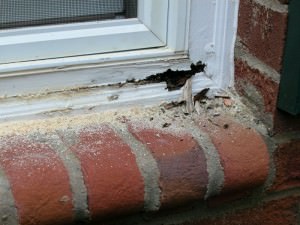Top 4 Ways Bats Get Into Your Home
 No one wants bats in their home, but if it happens, removing them is a high priority.
No one wants bats in their home, but if it happens, removing them is a high priority.
Getting control of a bat who’s managed to intrude into your premises isn’t easy and so to help you avoid such a situation I’m going to give you a list of the top ten ways a bad can get into your home.
Before I give you the list, I’d like you to know that I by all means think bats are beautiful creatures and I’m well aware that they contribute positively to any local ecosystem – even the world.
I’m writing this because once a bat or two do get into your home, there are a few dangers you can be faced with and so bat-proofing your home is of the utmost importance especially if you live in an area where they tend to roost.
Now, let’s get to the top 4 ways bats can get into your home.
Window shutters
You might never have believed it until you read it here today, but bats will actually build a colony in a homes window shutters. If you happen to neglect any windows in your home, you might be wise to check them every once in a while.
 To a bat, a window shutter is a simple and seemingly secluded place to built a roost and if you don’t know they’re there, you could end up with a family of them – or worse, you could find them ending up in your home.
To a bat, a window shutter is a simple and seemingly secluded place to built a roost and if you don’t know they’re there, you could end up with a family of them – or worse, you could find them ending up in your home.
WIndows that are covered up by brick or cardboard are also the usual suspects. Bats can live in their colonies for years before ever being suspected especially if a window is never used or has been covered up from the inside.
Gaps in mortar in bricks
For bats, cracks in bricks or it’s mortar is one of the easiest entry points. When it comes to bat control, it’s well known in the industry that bats can squeeze through a crack anywhere on your home that’s smaller than half a dime wide. According to a wildlife removal company I recently spoke to that offers, bats can squeeze through a crack anywhere on your home that’s about half a dime wide.
Once they get in, and if they feel they’ve found a safe area, they can roost and start building their colony.
What you can do is walk around your home a few times and look for any cracks or holes that a bat could get into. If you find any, repair them or seal them off.
Bats flying in through your door or windows
This one is common sense. There aren’t a whole lot of people that have had a bat come flying through there front or back door, but it happens and it happens mostly to people where areas allow for the breeding of bats.
So if you area you live in is prone to bats flying around this is when you’ll want to take some precautions. During the warmer seasons, make sure to keep your doors and windows closes, at least with a screen. To many, it seems as if there would be no real problem if a bat flew into their home – sure just take him outside – but the fact is, if the bat has rabies and you accidentally get bit, you could be in trouble.
The advice in this case would be to call a wildlife removal company.
Holes or gaps on your roof
Just like the gaps in bricks and mortar, bats can sneak into all sorts of cracks and openings on your roof too. Depending on the age of your home, the usual suspects are around the edges of the chimney, around or underneath the eavestrough, through small entry holes around dormers, and through cracks or crevices on shingles.
The roof is one of the easiest areas of the home a bat can find entry through – mainly because there’s no one manning the zone. Without being suspect or encountered by other predators, they can take their time to examine whether the area they’re looking to colonize is safe and warm. According to Bats Conservation International on attracting bats:
Bats have to find new roosts on their own. Existing evidence strongly suggests that lures or attractants (including bat guano) will NOT attract bats to a bat house. Bats investigate new roosting opportunities while foraging at night, and they are expert at detecting crevices, cracks, nooks and crannies that offer shelter from the elements and predators. Bat houses installed on buildings or poles are easier for bats to locate, have greater occupancy rates and are occupied two and a half times faster than those mounted on trees.
Give them a safe place to scope out an area to colonize and they will.
What this means is, if you live near a lot of bats, you need to get your roof checked out for intrusion points and seal them off. If you can’t do it yourself, then hire a wildlife removal company to do it for you.
Miscellaneous entry points
The above 4 points pretty much cover most entry points but you could be aware of random points of entry like old rusted pipes or forgotten holes created in the foundation of the home. If bats happen to be looking for a place to colonize and they stumble across an safe opening into your home, they’ll get in and it might be thousands of dollars and years later before you learn about it. Get your home checked out.